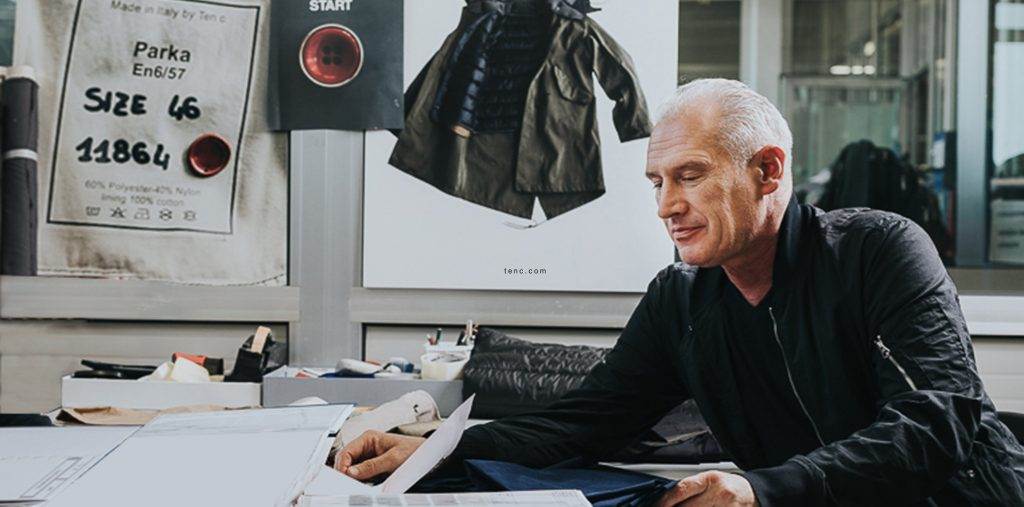This interview is taken from Issue 39 of our printed magazine, which is published twice a year. You can buy back issues here.

The Emperor’s New Clothes is a Danish folktale that relates an ethical lesson about vanity. Within it, the Emperor commissions a set of swindlers – unbeknownst to him – to make him an outfit. The swindlers convince the Emperor that they are expert weavers, but, importantly, weavers of a specific style of clothing: outfits that are invisible to anyone who is incompetent.
Say, by unfortunate circumstances, that you’re a bit thick, or a numpty, then you’d be unable to see the magnificent clothing that the weavers weaved. The Emperor was excited. He – of all people – could not possibly be a dimwit, so he was safe. He commissions an entire ensemble.
His advisors check the weaver’s progress. They peer over the loom and inspect the stitching. They watch the threads pass through fabric. But they can’t see anything. The outfit is invisible and the advisors begin to panic. They’re the Emporer’s advisors. They can’t admit incompetence or they’ll be fired. So they nod affirmatively and say “good job, old sport”, and pat the weavers on the back.
The Emperor receives his outfit and hides his shame. He can’t see the outfit, either. But his advisors dress him with confidence and comment on how good he looks. “It’s marvellous!” they shout. “Simply marvellous!”
The Emporer believes in the power of the weavers. Okay, he reasons, I’m a dimwit, but I can’t let anyone know about it.
He organises a procession and begins to tour the Kingdom. He struts through parades proudly; he’s carried on jewelled beds; he’s fed grapes, poured beer and wine and given delicacies.
The people are uneasy. We must be dimwits, they reason, and no one admits that they can’t see the Emporer’s clothes.
A small child is shuffling through the crowds, full of gusto and the innocent lust for life that makes it seem like every event is the first and every moment the last. He sees the Emporer, and with thoughtless immediacy blurts out: “The Emporer is naked!”
The crowds sigh in unison. They realise that they aren’t mad at all – the Emporer really is getting about completely naked.
It’s always better to speak your own convictions and not to let the crowd, or the opinions of others, sway your thought. It’s better, Ten c – an acronym for The Emporer’s New Clothes – argues, to boycott trends in favour of long-lasting garments. That’s the philosophy of Ten c: longevity, timelessness, the sort of clothes that fill you with trend-transcending self-confidence. Ten c’s clothes speak for themselves, and unlike the Emperor’s, they don’t depend on the validation of others.
Alessandro Pungetti’s office in Bologna looks like an airport hanger or the inside of a science lab from the 60’s. It looks like the type of place you’d find blueprints describing how to reverse engineer an alien spaceship, which is kind of what Pungetti does – except he isn’t using futuristic materials to design spaceships. He’s using futuristic materials to design clothes.
Pungetti has a star-studded CV with some of the biggest names in Italian fashion: Stone Island, Iceberg, Missoni, Paul & Shark, Moschino, and others. It reads like a who’s who list of a very specific type of Italian design, and it all leads up until this point. “If you want to create a product of the highest level, you can only do it in Italy,” claims Pungetti.
When Pungetti discovered a fabric called Original Japanese Jersey (OJJ), although really challenging to treat and dye, he instantly knew that this was a material with great promise. OJJ is manufactured exclusively in Japan, prepared for dyeing, and then shipped to Ten c in Italy, where the technicians get to work. What sets the material apart from others is its genetic make-up: the Original Japanese Jersey is an interlock jersey composed of 60% polyester and 40% nylon yarn, and then the material is dyed at 130° in a hot solution. The result is a material that’s initially rigid, but softens on the wearer.

“The composition of the fabric even changes according to climatic influences; if it’s humid the material becomes very soft, but if it’s dry it becomes hard and stiff. When you feel the OJJ fabric, you can immediately feel the weight and technicality of the fabric, and it’s what makes Ten c garments unique.”
The high temperatures and pressures of Ten c’s garment-dyeing technique result in unique properties: the final product has a denim-like structure that’s aged and naturally wind and water-repellent, producing a highly desirable beading effect as water droplets hit the outer. It’s a heavy material that found its best applications in outerwear, like Ten c’s infamous Cyclone Parka, which is based on German snorkel parkas of the late 60s. Ten c’s parkas and liners are designed to be integrated with one another, adding a modular dimension.
Exploring the range of OJJ’s possibilities is one of Ten c’s missions. Dyeing blends of fabrics is always challenging as different materials react to different temperatures, producing various shrinkages and stresses. In order to counteract this, Ten c has developed methods of piece-dyeing for spring-summer ‘22. Piece-dyed items are lighter than traditional garment-dyed bits, which opens up the range of possibilities for lighter styles.
Pungetti explains how the brand has been experimenting: “we’ve reached some important milestones in recent seasons, extending our offering to include additional materials such as down-filled Nylon Tactel and Transparent Rip-Stop Nylon, combined with different techniques such as laser-cut OJJ.”
These new techniques and technologies facilitate the production of new materials into the brand’s roster, like the Shearling Liner, a hybrid of nylon down-filled arms, a shearling front and a fleece inner.
Every year, since the 1952 beginnings, or at least every year when there isn’t a global pandemic, the city of Florence, Italy, fills to the brim for Pitti Uomo. The event was held earlier in January this year, where brands display their creations and fashion’s ‘it’ list flaunts around to a backdrop of street photographers. Outfits vary from outrageous and colourful to well-tailored and clean-cut. There are classic menswear ensembles, esoterically eccentric outtakes reminiscent of Vivienne Westwood, dandies, full-time flaneurs, Japanese Americana-infused denim lovers, streetwear obsessives, and, as the last few year’s trends have shifted, a rising number of tech-loving outerwear enthusiasts.
Ten c presented their ‘Hybridisation’ AW22 at Pitti Uomo, teasing the brand’s range of parkas, puffers, trousers and mid-layers in a range of shades, from neutral, the Ten c-synonymous mandarin orange, and a bright Klein blue – the latter a reference to the work of nouveau realist, Yves Klein. All of these new releases are built around the OJJ core, where the introduction of merino wool knitwear, sheepskin inserts and nylons are complimented, or, in Pungetti’s words, playing to the feel of his Bologna science lab, “contaminated” with OJJ inserts.
Amongst the sea of journalists at Pitti Uomo, Tom Stubbs – stylist, writer, flaneur – on behalf of Vogue, spotlighted Ten c with these words: “If someone is wearing Ten c, and you have the eye to spot it, you can bowl up and begin to converse freely without introduction,” hinting at the community embedded in the technical menswear world. In a way, it’s escaping the snobby elements often associated with fashion and menswear shows. People want to touch clothes, to feel them, to dissect them, and when the opportunity reveals itself, it has to be seized. Much like the young boy at the Emporer’s parade who couldn’t hold his tongue, Ten c wants people to communicate and to speak their minds.
But despite the love felt at Pitti Uomo – an event that, like various Fashion Weeks and fashion in general, is often considered fickle – Ten c doesn’t seek out trends to service them. Ten c try to create items that will last forever.
“I have always looked towards longevity and a sense of timelessness,” says Pungetti. “I’m pleased to see that increasingly consumers are looking for this. This is the philosophy of Ten c. These garments become an integral part of people’s daily lives for a long time.”
Of course, the manifesto is not just craft motivated, but environmentally. This, argues Pungetti, is “sustainability in the workplace itself.” It’s creating items that are cared for, adored, loved, trusted in the hands of the next generation.

In a reach for aesthetic timelessness, Ten c use no overt branding. Taking inspiration from Japan’s Imperial Seal, the brand’s only logo is a wax stamp in the shape of the chrysanthemum. Hot wax is poured onto the inner tag of each jacket and stamped, like a letter would be sealed, leaving each jacket imprinted with a red imprint of approval.
In Hans Christian Andersen’s original fable, The Emporer’s New Clothes, a sigh of relief spreads throughout the crowd after the small boy shouts out “The Emporer is naked!” At first, the child’s father tries to correct him. He pushes him, tries to make him conform to the collective approval. But the news spreads throughout the crowd and everybody realises that there’s nothing to see. There’re no clothes, no implicit reference to their own stupidity. The table has turned, and The Emporer, in his naked glory, can’t concede: he continues with the procession, strutting more proudly than ever. To concede would be to profess gullibility. It’s better for him to believe he is the only man wise enough to see the clothes, and his advisors, afraid to lose their jobs, continue with the falsitude.
The fable was intended as a children’s story, so the significance of the child spectator shouting out is important: it’s encouraging children to speak their minds. But importantly, it’s showing them the dangers of vanity and how it can lead to dangerous decision-making. The con artists took advantage of The Emporer. Ten c is arguing these weavers are equivalent to trends. By buying clothes without understanding their impact on the environment, or caring about their craftsmanship, you are undermining yourself. The fleeting beauty of trends is an illusion. The reliability of well-made, well-constructed and well-thought-out clothing is Ten c’s biggest strength, and that is timeless.
